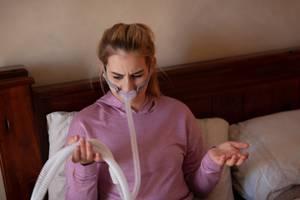Recalled CPAP Machines May Have Caused Exposure to Dangerous Chemicals
 Since the medical equipment manufacturer Philips Respironics began recalling millions of CPAP and BiPAP machines and ventilators in 2021, users of these devices have been concerned about the potential health risks that may have affected them. The recalled devices contained a polyurethane foam that could break down during regular, daily use, and the inhalation of particles and chemicals may have led to multiple types of health issues. By understanding the specific substances that people may have been exposed to and their potential effects, CPAP users can determine whether they have suffered harm, and they can work with an attorney to determine their legal options.
Since the medical equipment manufacturer Philips Respironics began recalling millions of CPAP and BiPAP machines and ventilators in 2021, users of these devices have been concerned about the potential health risks that may have affected them. The recalled devices contained a polyurethane foam that could break down during regular, daily use, and the inhalation of particles and chemicals may have led to multiple types of health issues. By understanding the specific substances that people may have been exposed to and their potential effects, CPAP users can determine whether they have suffered harm, and they can work with an attorney to determine their legal options.
Potentially Harmful Chemicals That May Affect CPAP Users
Testing performed by Philips determined that the breakdown of the foam used in CPAP machines and other devices may have caused users to inhale small foam particles. These particles contained multiple types of toxic chemicals, including:
-
Toluene diamide - This chemical can cause irritation of the nose and throat, as well as skin conditions such as dermatitis. It can also cause nausea and vomiting, respiratory depression, headaches, weakness/fatigue, dizziness, convulsions, loss of muscle coordination, blood disorders, or damage to the liver. A person may experience cyanosis, or a bluish color in their skin, due to decreased amounts of oxygen in the blood. The chemical has also been associated with cancer affecting the liver, skin, and breasts.
-
Toluene diisocyanate - This chemical is a carcinogen that has been linked to cancer of the pancreas, liver, skin, breasts, and circulatory system. It can also irritate the mucous membranes in the respiratory system and gastrointestinal tract, and it may lead to conditions such as bronchitis or asthma.
-
Diethylene glycol - This chemical has been associated with seizures, kidney failure, a condition known as metabolic acidosis in which the blood becomes too acidic, and mental health issues such as depression.
The breakdown of foam in CPAP and BiPAP devices has also been found to release chemicals known as volatile organic compounds (VOCs). This may have caused users to inhale dangerous chemicals such as:
-
Dimethyl diazene - This chemical has been linked to adenocarcinoma, a form of cancer that affects mucus glands lining different organs; this cancer may spread and affect the breasts, prostate, pancreas, esophagus, colon/rectum, stomach, or lungs. It may also cause brain edema, or a buildup of fluid in the cranium that may cause damage to the brain.
-
Phenol - This chemical can cause irritation to the nose and throat, and exposure may lead to unhealthy weight loss, fatigue, aches and pains in the muscles, damage to the liver and kidneys, cyanosis, dermatitis, convulsions, or a condition known as ochronosis that causes discoloration of the whites of the eyes or skin on the face, ears, and nose.
Contact Our CPAP Recall Attorneys
Users of the recalled CPAP machines may have been unknowingly exposed to multiple types of harmful substances, and they may have experienced a variety of health issues as a result. If you or a member of your family have used one of the recalled devices, and you have suffered from health issues that may have been caused by the inhalation of toxic chemicals or substances, we can help you determine your legal options. Contact our CPAP injury lawyers today to arrange a free consultation and learn how we can help.
Sources:
https://www.philips.com/c-dam/b2bhc/master/landing-pages/src/update/documents/philips-recall-clinical-information-for-physicians-and-providers.pdf
https://www.cdc.gov/niosh/npg/npgd0620.html
https://www.cdc.gov/niosh/docs/90-101/default.html
https://www.sciencedirect.com/topics/medicine-and-dentistry/diethylene-glycol
https://www.cdc.gov/niosh/npg/npgd0493.html
https://pubchem.ncbi.nlm.nih.gov/compound/Azoxymethane
 20 N Clark Street, Suite 3300, Chicago, IL 60602
20 N Clark Street, Suite 3300, Chicago, IL 60602


